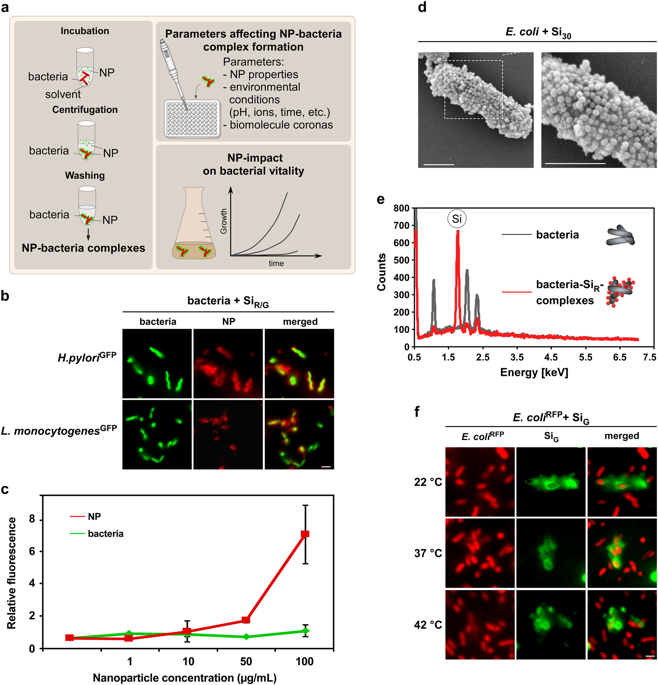npj Science of Food ( IF 6.4 ) Pub Date : 2018-12-04 , DOI: 10.1038/s41538-018-0030-8 Svenja Siemer 1 , Angelina Hahlbrock 1 , Cecilia Vallet 2 , David Julian McClements 3 , Jan Balszuweit 4 , Jens Voskuhl 4 , Dominic Docter 1 , Silja Wessler 5 , Shirley K Knauer 2 , Dana Westmeier 1 , Roland H Stauber 1

|
Nanotechnology provides the food industry with new ways to modulate various aspects of food. Hence, engineered nanoparticles (NPs) are increasingly added to food and beverage products as functional ingredients. However, the impact of engineered as well as naturally occurring NPs on both commensal and pathogenic microorganisms within the gastrointestinal tract (GI) is not fully understood. Here, well-defined synthetic NPs and bacterial models were used to probe nanoparticle–bacteria interactions, from analytical to in situ to in vitro. NP–bacteria complexation occurred most efficiently for small NPs, independent of their core material or surface charge, but could be reduced by NPs’ steric surface modifications. Adsorption to bacteria could also be demonstrated for naturally occurring carbon NPs isolated from beer. Complex formation affected the (patho)biological behavior of both the NPs and bacteria, including their cellular uptake into epithelial cells and phagocytes, pathogenic signaling pathways, and NP-induced cell toxicity. NP–bacteria complex formation was concentration-dependently reduced when the NPs became coated with biomolecule coronas with sequential simulation of first oral uptake and then the GI. However, efficient NP adsorption was restored when the pH was sufficiently low, such as in simulating the conditions of the stomach. Collectively, NP binding to enteric bacteria may impact their (patho)biology, particularly in the stomach. Nanosized-food additives as well as naturally occurring NPs may be exploited to (rationally) shape the microbiome. The information contained in this article should facilitate a “safe by design” strategy for the development and application of engineered NPs as functional foods ingredients.
中文翻译:

纳米食品添加剂影响人体肠道中的有益菌和致病菌:一项模拟胃肠道研究
纳米技术为食品工业提供了调节食品各个方面的新方法。因此,工程纳米粒子 (NPs) 越来越多地作为功能成分添加到食品和饮料产品中。然而,工程和天然存在的 NPs 对胃肠道 (GI) 内的共生微生物和病原微生物的影响尚不完全清楚。在这里,定义明确的合成纳米粒子和细菌模型被用来探测纳米粒子-细菌的相互作用,从分析到原位到体外。NP-细菌复合对于小 NPs 发生的效率最高,与它们的核心材料或表面电荷无关,但可以通过 NPs 的空间位阻表面修饰来减少。对于从啤酒中分离的天然存在的碳纳米粒子,也可以证明对细菌的吸附。复合物的形成影响了 NPs 和细菌的(病理)生物学行为,包括它们的细胞摄取到上皮细胞和吞噬细胞、致病信号通路和 NP 诱导的细胞毒性。当 NP 被生物分子冠覆盖时,NP-细菌复合物的形成呈浓度依赖性减少,依次模拟首先口服摄取,然后是 GI。然而,当 pH 值足够低时,例如在模拟胃的条件下,可以恢复有效的 NP 吸附。总的来说,NP 与肠道细菌的结合可能会影响它们的(病理)生物学,特别是在胃中。纳米级食品添加剂以及天然存在的 NP 可用于(合理地)塑造微生物组。



























 京公网安备 11010802027423号
京公网安备 11010802027423号